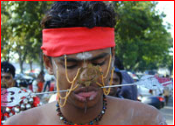Why do people pierce their body with hooks and lance during Thaipusam?
People piercing their body with hooks, skewers and (vel) small lances during Thaipusam at Murugan Temples is a common sight. In the beginning people only used to pierce their tongue with a small vel - this was a means to meditate by keeping silent.
The vel was used to create a forceful means for Mauna Vratam - remaining silent. In the beginning it was a simple innocent offering done by Muruga Devotees.
But today in some instances, Lord Muruga devotees pull heavy chariots with hooks attached to their bodies - this is a very recent trend.
Such practices are not mentioned in Hindu Holy Scriptures. In Holy books, body is quite often mentioned as the temple in which Brahman resides. ‘Vel’ was presented to Lord Muruga by Mother Parvati to vanquish the demons and not to pierce his body. Even the stories associated with taking Kavadi has nothing to with body piercing.
But piercing cheeks and tongue with ‘vel’ is a common practice by devotees of Lord Muruga. In Malaysia, it goes a step forward and some devotees pull heavy objects up the Batu Caves using hooks attached to the body.
Most people perform such piercing to fulfill their wishes. They believe that Muruga will be easily pleased, if the degree of such antics are increased. Ignorance of the basic tenants of Hinduism is the reason behind such practices. People get nothing but mental satisfaction and body pain from such piercing.
But these practices have been taking place for thousands of years and several symbolisms have been attached to these practices.
Piercing of the tongue is done to stop the speech and thereby to concentrate fully on the Lord.
Another symbolism states that it is to show that the physical body is a ‘maya’ and ultimate aim is to merge with the Brahman. There are several other symbolisms.
Most devotees enter into a trance during the piercing mainly due to the excessive drumming and chanting. They claim that they experience no pain during piercing and even after the ritual.
Adi Shankaracharya speaks about rituals like this:
Rituals are like blankets that veil the truth. They are nets to trap our intellect, forcing us to confine our consciousness to the superficial values of the manifest world. The thinking of a person who believes exclusively in ritual practices becomes confined to this little world. Subtle thoughts of the mind and tender feelings of heart become outward oriented. Such a person begins to believe that everything can be accomplished with the help of rituals.




